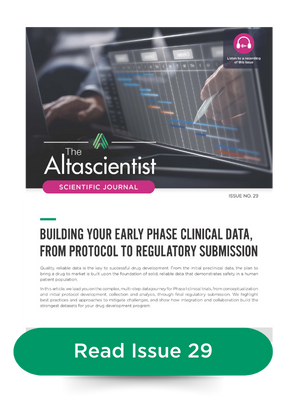ISSUE NO. 29 — Building Your Early Phase Clinical Data, from Protocol to Regulatory Submission

Quality, reliable data is the key to successful drug development. From the initial preclinical data, the plan to bring a drug to market is built upon the foundation of solid, reliable data that demonstrates safety in a human patient population.
In this journal, we lead you on the complex, multi-step data journey for Phase I clinical trials, from conceptualization and initial protocol development, collection and analysis, through final regulatory submission. We highlight best practices and approaches to mitigate challenges, and show how integration and collaboration build the strongest datasets for your drug development program.
In Issue 29 of The Altascientist:
• Protocol development
• Data management
• Statistical support
• Analysis and reporting
Clinical Trial Protocol Development—The First Important Step
Developing a protocol is the first step in making your study design a concrete, actionable plan to generate data for regulatory submission. Meticulously documented and validated, a well-designed protocol provides the structure for the trial activities that will generate the data to support the study objectives; it is integral to the success of any drug development program.
The credibility of the data from the clinical trial is mainly dependent on the trial design. The trial design in the protocol defines the endpoints and study type (double-masked, placebo-controlled, parallel design), and includes detailed information about the investigational product (IP), the anticipated duration of subject participation, and the sequence and duration of all trial periods, including follow-up. Discontinuation criteria are also key elements for data-driven decision-making during study conduct.
In addition, the protocol includes the description of the analysis and statistical methods to be employed, including timing of any planned interim analyses and quantification of the approach, such as selection criteria for analysis populations (all randomized, all dosed, all eligible, etc.), sample size, calculation of power of the trial, and clinical justification. Finally, the protocol details procedures for reporting any deviations from the original statistical plan, and the use of any excess, missing, or spurious data.
Once the study protocol is final, it becomes the foundation for additional and more detailed study documents, including the Data Management Plan (DMP) and Statistical Analysis Plan (SAP). Here, the first steps of the data journey truly begin.
How Altasciences Will Support Your Clinical Trial Data
At Altasciences, we take pride in the way we handle your data and facilitate your journey. We have a talented, experienced, and integrated team, whose collaborative efforts ensure that your data is collected and managed with the utmost speed, efficiency, and respect for quality.
Following rigorous processes and standard operating procedures and leveraging a deep and broad knowledge of CDASH and CDISC guidelines, we ensure that your critical trial data is delivered in a regulatory-compliant format. Our PK and PD experts ensure that all analyses are carried out with rigor in a timely fashion so that the data is thorough, accurate, and actionable. When you partner with us, you need never be concerned about the quality, security, or accuracy of the data you present in support of your drug development program.
Explore all issues of The Altascientist in our Resource Center. And don’t forget to subscribe to “The Altascientist: Audiobooks” on Spotify, Apple Podcasts, or wherever you get your audio content.
Download publication